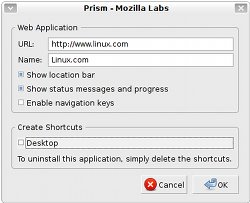Author: Nathan Willis
The Mozilla-based, single-site “Web app” browser Webrunner, which we covered in July, was rebrandedMozilla Prism in October and moved to the Mozilla Labs site. Initially, Prism was only available for Windows, but Mac and Linux builds are now available.
Webrunner was designed to better integrate Web-based applications into the desktop by allowing you to launch them as separate processes. Each Web app could have a launcher in the system dock, panel, or Applications menu, and when launched each ran in its own window, stripped of the toolbars and navigation controls of a full browser.
The current 0.8 release of Prism sports the Gecko 1.9 rendering engine found in the newest Firefox 3 betas. You can download prebuilt Prism binaries for Linux, Mac OS X, and Windows. On Linux the package is a compressed tarball you can unpack to any directory on your system. There is no installer; you can start using Prism immediately.
From a command line, you start Prism by running ./prism &. You will immediately notice the biggest change over Webrunner. When we last looked at Webrunner, it relied on .webapp files, passed as command-line arguments to specify which site to load. Now Prism launches a dialog box, into which you type the URL of the desired page and the name you want to assign to it, and click OK. Prism will then launch the site, and create a system-specific launcher in the location of your choice. On Linux systems, this is a .desktop file of the Freedesktop.org Desktop Entry Spec variety, created on your desktop.
Inside the .desktop file, the Exec= line contains a link to an automatically generated .webapp file. These are stored inside your default Mozilla profile directory. The .desktop file also specifies the icon for the launcher, so you can change it if you do not care for Prism’s selection.
This is a far easier process than creating each .webapp by hand. You even have the option to choose a few display preferences when setting up your Web app, including the ability to display the location bar and status bar. Both can be helpful during a Web app session, even if you never leave the original site.
Mind the gaps
Prism’s developers invite comments, questions, and feedback through the Mozilla Labs forum. Users have expressed interest in fleshing out Prism’s features in a variety of directions.
Several have noted that their Prism Web apps do not pick up the existence of Firefox plugins like Flash, although this seems to depend on where the Flash plugin is installed. If you install Prism inside your home directory, it will find plugins installed inside the .mozilla directory in your home directory, but not system-wide plugins in /usr/lib.
Prism does support extensions, but as yet there is no interface for installing, loading, or unloading them. Developer Mark Finkle blogged about how to manually get extensions installed and running, but cautioned readers that because Prism is such a stripped-down browser, many extensions written for Firefox simply will not work because of the missing components.
On a more practical level, so far there is no support for using Prism through a Web proxy, which might affect users inside corporate environments.
The informal roadmap for the project includes several key features to integrate a running Web app better with the surrounding desktop system — drag and drop, offline usage, and interaction with desktop event notifications, to name a few.
Forum readers have suggested adding a minimal Preferences interface, an idea toward which the developers indicate an openness. Although many of Firefox’s preferences would not make sense in the site-specific browser context, others — such as control over fonts, cookies, and private data — certainly do.
If you have been using Webrunner, switching over to Prism is worth your while for the simplified launcher creation. If you have not tried either incarnation, be sure to check out this simple but valuable tool.
Categories:
- News
- Internet & WWW
- Desktop Software



